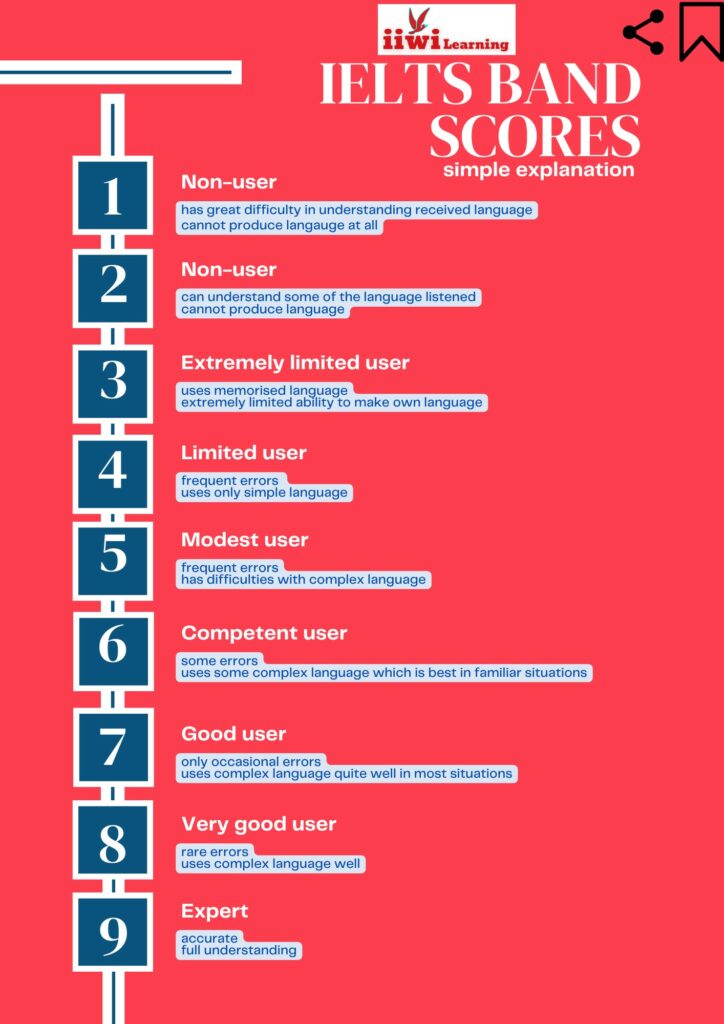Everything about Speaking bands, descriptors and criteria
You are not serious for IELTS Preparation if you don’t comprehensively understand these three things-
1. Test Format
2. Band scores
3. Band Descriptors
You will cut a BIG LOSS and have a huge dip in confidence before Test day if you ignore any of these three topics. Don’t let that happen!
To know the Test Format and the disadvantages of not knowing it thoroughly. (hyperlink)
To know band Scores and the disadvantages of not knowing them thoroughly. (hyperlink)
And from this post, you will get a full understanding of band score descriptors, learn what band score is your target, and what band score you currently fall into. In other words, from this post, you will have a clear picture of the starting and ending points of your IELTS Preparation. You will appear for IELTS with great confidence and maximize your chances of getting the desired score in the first shot.
TABLE OF CONTENT
Point 1: What is a band score? (Recap)
Point 2: What is a band description/ band descriptor?
Point 3: 5 Reasons why it is important to understand band descriptors?
Point 4: 4 Main Assessment Criteria for IELTS Speaking
Point 5: Wrong Understanding (myths) about Fluency & Coherence
Point 6: What are Fluency & Coherence basically
Point 7: Wrong Understanding of Lexical Resource
Point 8: What is Lexical Resource basically
Point 9: Wrong Understanding (myths) about Grammatical Range and Accuracy
Point 10: What is Grammatical Range and Accuracy basically
Point 11: Wrong Understanding (myths) about Pronunciation
Point 12: What is Pronunciation basically?
Conclusion
Point 1: What is a band score? (Recap)
A band score is a numerical score that corresponds to a level of language proficiency (level of ability).
The band scores are standardized by Cambridge Assessment English, the organisation that designs Beginner to Advanced English proficiency tests worldwide. They design IELTS tests and evaluation criteria too.
Cambridge Assessment English, keeps the range of their band scores from 0 to 9, with 9 being the highest score.
Each band score represents a level of language proficiency according to the standards set by the Common European Framework of Reference for Languages (CEFR). The CEFR is a widely recognized framework for describing language proficiency. It is used by language schools, universities, and employers around the world.

Point 2: What is a band description/ band descriptor?
A band description is a set of guidelines that tells the level of English language proficiency shown by test taker. Each band descriptor provides a detailed explanation of what test takers at each level are capable of doing in terms of language skills.
Each Language Skill – IELTS Section has its separate band descriptions from 0 – 9, and each band score corresponds to a specific level of English proficiency for the particular language skill.
Here’s an IELTS general band score chart. You can see that each band describes the language user’s competence level i.e. Non—user, good user, competent user etc.

Point 3: 5 Reasons why it is important to understand band descriptors?
Let me tell you outright if you think you can skip understanding the band scores, you will be in major trouble. You will keep preparing and you won’t know how near or far you are from your target score. You will be on a wild goose chase if you start IELTS preparation without knowing the band descriptors of each of the four IELTS Sections. So here are the five reasons you must, must, must know band descriptors in detail –
- You ought to know what is expected: The band descriptors provide a detailed explanation of the skills and abilities that a test taker must demonstrate in each IELTS Section to achieve a particular band score. If you don’t understand band descriptors you won’t be able to perform according to the criteria and get the desired score.
- To set goals: If you know the band descriptors you can set realistic goals for yourself. By understanding the ability level that is required to achieve your desired band score, you can work towards it and develop a plan to improve.
You can self-assess your ability levels, know your current band score and determine the target skill level you need to achieve for your desired band score. - To identify areas for improvement: When you see a particular band descriptor you understand what abilities of the desired band score you already have and what abilities you are weak in.
It becomes easy for you to focus your study efforts and develop strategies to improve and reach your target language skills. - To better prepare for the exam: You can prepare much better for the exam. You can concentrate on practicing the specific language skills that are required for your target band score. Especially for those who don’t have time or are doing IELTS Preparation at home, understanding band descriptors is one of the most essential steps for pre-planning your IELTS preparation.
- To track your language skill progress: The band descriptor details are like the steps on the ladder. The band descriptor detail tells you your current level and when your score improves in Practice Tests you get accurate evaluation of your progress.
Point 4: 4 main Assessment Criteria for IELTS Speaking
The four key assessment criteria for IELTS Speaking are –
• Fluency & Coherence (FC)
• Lexical Resource (LR)
• Grammatical Range and Accuracy (GRA)
• Pronunciation
You may think that you know what all these four criteria are but you are advised to read through the explanations of all the four criteria to complete your understanding right from the basics.

Point 5: Wrong Understanding (myths) about Fluency & Coherence
Myth 1. Fluency means speaking quickly.
Reality: Fluency is more about a speaker’s ability to express effortlessly and naturally, without stumbling over words or pausing often.
Myth 2. Fluency is something you are born with.
Reality: Anyone can improve fluency with practice and exposure to the language. Becoming Fluent needs consistent effort and dedication.
Myth 3. Fluency is the same as accuracy.
Reality: Fluency is more about the ability to express oneself effortlessly and naturally.
Myth 4. Fluency is only important in formal or academic settings
Reality: Fluency is important in all settings, including casual conversations and social interactions. Fluency helps build stronger relationships and connections with others.
Myth 5. Coherence means expressing ideas in a strictly linear and logical fashion, with no room for creativity or originality.
Reality: Coherence is a speaker’s creativity and originality in presenting ideas in a way that is more easily understood by the audience.
Myth 6. Coherence is only important in formal or academic settings.
Reality: Coherence is important for effective communication in all settings, including casual conversations and social interactions.

Point 6: What are Fluency & Coherence basically
Fluency is the ability to speak a language with easily, accurately, and in continuity. If you are fluent you can produce sentences and expressions on the spot for what you want to say with use of appropriate grammar, vocabulary, intonation, and pronunciation.
Coherence is the ability to be logically sound, orderly, and understandable. Being coherent means you can communicate ideas or information in a smooth sequence, without contradictions or conflicts in reasoning, and make sense as a whole.
If you want to develop fluency and coherence you need training in reasoning abilities, clarity of thinking, ability to organize and structure information, and learning how to logically present ideas.
The case with non-fluent speakers
- Have a lot of hesitation: Non-fluent speakers may pause frequently while speaking and struggle to find the right words or expressions to convey their thoughts.
- Make a lot of Grammatical errors: They may make frequent grammatical errors, such as incorrect verb tenses, subject-verb agreement, and word order.
- Have a limited vocabulary: Non-fluent speakers may have a limited vocabulary and may struggle to find the right words to express themselves.
- Have incorrect pronunciation: They may have difficulty with correct pronunciation, which can make it hard for others to understand what they are saying.
- They lack coherence: Non-fluent speakers may have trouble organizing their thoughts and ideas in a logical and coherent manner, making it difficult for listeners to follow their conversation.

Point 7: Wrong Understanding (myths) about Lexical Resource
- People think the lexical resource is about using more complex and sophisticated vocabulary that always makes a speaker sound more intelligent and impressive.
But what is important is to use words and phrases that are appropriate for the context and audience. In fact, research suggests that using simpler language can actually make a speaker more persuasive and engaging. - People think that lexical resource is only important in formal or academic settings. But in reality, having a strong vocabulary is actually essential for effective communication in all settings, including casual conversations and social interactions (to build stronger relationships and connections with others).

Point 8: What is Lexical Resource basically
Lexical Resource is the total stock of words and phrases used or the vocabulary used by a speaker.
It is the range, quality, and accuracy of vocabulary a person has.
A strong lexical resource involves not only knowing a wide range of words but also being able to use them correctly and fluently in speech and writing.
To develop a strong lexical resource, one has to read widely, listen to native speakers, and practice using new vocabulary in context. Using online resources such as dictionaries, thesauruses, and vocabulary-building apps can also be helpful. Regularly talking or writing to people can help to improve one’s vocabulary and ability to use words effectively.

Point 9: Wrong Understanding (myths) about Grammatical Range and Accuracy (GRA)
Myth 1. Grammar drills are the best way to improve your grammatical range and accuracy.
Reality: While grammar drills are not that helpful. Instead contextualized language practice, such as reading and listening to authentic materials, can be more effective than isolated grammar exercises.
Myth 2. You need to learn all the grammar rules of a language to communicate effectively.
Reality: It is impossible to learn all the grammar rules of a language, and attempting to do so can be boring, tiring and never as useful as expected. Instead, it is better to focus on the most commonly used grammar structures and to learn them in context.
Myth 3. If you make a grammatical error, you should immediately correct it.
Reality: It is important to be aware of your grammar errors but correcting them in the middle of a conversation can interrupt the flow of communication. So, it is often better to continue speaking, make a mental note and review the grammar rule application later.
Myth 4. Native speakers never make grammatical errors.
Reality: Even native speakers make grammatical errors, especially in informal settings. In fact, many native speakers are not even aware of some of the grammar rules of their own language.

Point 10: What is Grammatical Range and Accuracy (GRA) basically
Grammatical RANGE and ACCURACY are two important aspects of language proficiency.
The grammatical range is the variety and complexity of grammatical structures that a person is able to use.
Your grammatical range is about your ability to use a wide range of sentence structures, verb tenses, and other grammatical forms to express yourself effectively in different situations and for different purposes.
Grammatical accuracy, on the other hand, is about the correctness and precision of a person’s use of grammar.
Your grammatical accuracy is about using grammar rules correctly, avoiding errors in grammar and syntax, and producing sentences that are grammatically sound and suitable for the context.
In language testing and assessment, both grammatical range and accuracy are often evaluated as separate components of overall language proficiency.
Point11: Wrong Understanding (myths) about Pronunciation
Myth 1: Pronunciation doesn’t matter as long as you know the words and grammar.
Reality: Clear pronunciation is essential for accurate communication, especially in situations like job interviews or presentations. If words are poorly pronounced, listeners will not get the correct meaning. Communication becomes unsuccessful.
Myth 2: There is only one “correct” way to pronounce a word.
Reality: There are often several acceptable ways to pronounce a word, depending on regional dialects and accents. It’s important to focus on clear communication rather than copying a native accents.
Myth 3: Native speakers always pronounce words the same way.
Reality: Even native speakers may pronounce the same word differently in different contexts or depending on their mood or level of formality. Pronunciation can change over time.
Myth 4: Pronunciation is just about getting the sounds right.
Reality: Pronunciation is also about intonation, stress, and rhythm. These factors can affect the meaning and emphasis of a sentence, and can also vary across different languages and dialects.
Myth 5: Once you learn the rules of pronunciation, you don’t need to practice anymore.
Reality: Like any skill, pronunciation requires ongoing practice and feedback to improve. It’s important to continue to listen to native speakers, record yourself, and get feedback.
Pronunciation improvement will always require feedback from a trainer. It is very difficult for learners to identify where their pronunciation is going wrong.
Point 12: What is Pronunciation basically
Pronunciation is the way in which the sounds of the words are produced and the way in which the stress and intonation are used to convey meaning. Good pronunciation helps in effective communication and understanding of a language.
Intonation refers to the rise and fall of the pitch of the voice when you speak. The rise and fall of pitch is used to express emotions, signal the end of a sentence or question, or convey a particular emphasis or meaning. Different languages and dialects have their own unique intonation patterns.
Pronunciation and intonation are both important aspects of spoken language, but they refer to different aspects of how words are spoken.
Don’t ever again get confused between Pronunciation & Intonation
Now, that you are clear about all the four main criteria of IELTS Speaking let’s proceed to see the band descriptors for each band score for IELTS Speaking.
But just a minute, remember the aim of all this information is to help you one, to understand the IELTS system and two, to help you succeed in your IELTS preparation. One of the main basis of preparing for an exam is to know your current level and know the gap from the target level. The key to preparing for IELTS Exam is self-assessment.
So, a tip before giving you the Speaking band descriptors.
Tip for Self-Assessment: While assessing your IELTS band score, rate yourself for one criterion at a time. Rate yourself on Fluency and Coherence first, then Lexical Resource, Grammatical range & Accuracy next, and lastly pronunciation.
Then take an average. Although this is not the way the IELTS Examiner will assess you then you’re not as trained as them. And you need to go step by step.
After the band score descriptors are given below, I’ve also given a self-assessment band score chart criteria-wise for helping self-assessment. Don’t be generous when you’re assigning yourself a band score. Be stingy. Preparing for IELTS is best that way!

Founder- IIWI Learning IELTS 8+ Coach, 30 yrs exp.|Author|Blogger


Leave a Reply